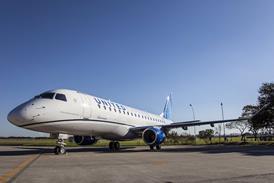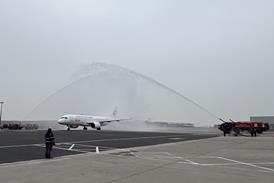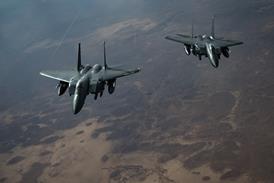There is a resurgence in interest in South Korea's fighter aircraft requirements, with the east Asian country deciding on a variety of aircraft as part of an ongoing modernisation of its air force's capabilities.
The choices represent a mix of imported and indigenous solutions, with the country trying to find a way to match its operational requirements with a desire to promote the local industry, mainly state-owned Korea Aerospace Industries (KAI).
South Korea has maintained three levels of fighters - low, medium and high - as part of its operational capability. At the low level are Northrop F-5s, at the medium level McDonnell Douglas F-4s, and Lockheed Martin F-16s and Boeing F-15Ks at the high level. Replacements are being considered at all levels.
For the low-level requirement, the government finally awarded 400 billion won ($306 million) to KAI to develop a prototype of a light attack version of its T-50 advanced jet trainer, with a production contract likely to be awarded after the aircraft has been tested by the nation's air force.
 |
|---|
© Boeing |
"Under the contract, KAI will upgrade four T-50s to the F/A-50 standard and deliver them to the air force by 2012. KAI expects the air force to order around 60 F/A-50s for delivery from 2013 to replace its F-5s, and eventually buy up to 150 of the type," says the company.
This follows years of intense efforts by KAI to get financial support for the F/A-50's development and keep its T-50 production line open beyond 2012, when the last South Korean aircraft under contract are delivered. Its air force has ordered 82 T-50s, including 50 advanced jet trainers, 22 armed A-50s and 10 for its aerobatics display team. The service could order another 70 trainer and weaponised variants, say sources, and the T-50 is in contention in several international tenders.
Foreign input has been crucial to the T-50, which was developed with extensive help from Lockheed. The F/A-50 is tagged as an indigenous aircraft, but it will also depend on foreign suppliers to a large extent. KAI issued tenders in 2008 to suppliers of radar warning receivers, precision-guided bombs, countermeasures dispensers, advanced tactical datalinks and weapons management systems for the F/A-50.
Known armaments will include bombs equipped with Boeing Joint Direct Attack Munition guidance kits and Raytheon's AGM-65 Maverick air-to-surface missile.
Israeli companies are early beneficiaries, with the F/A-50 likely to use an EL/M-2032 radar supplied by Elta Systems. The radar has been a bone of contention with Lockheed, which had wanted KAI to use its own APG-67(V)4. Seoul had preferred Selex Sensors and Airborne Systems' Vixen 500E active electronically scanned array, but is barred from sharing the T-50's source codes with non-US companies. That led to it choosing the Israeli radar, which will be installed on the F/A-50 by a US company, meeting US government and Lockheed conditions.
AIRCRAFT PROTECTION
Israel's Elisra has also been selected to supply electronic warfare equipment for the F/A-50, under an initial contract worth $7 million. Elisra will develop and produce prototype equipment to be supplied to KAI over the course of the next two years.
Elisra sources indicate that the selected EW system will include radar warning receivers and chaff and flare dispensers. "We cannot release more details, but we talk about a very efficient system that will give the aircraft excellent protection," says one.
In September, the South Korean government reaffirmed its support for the F/A-50's development by increasing the research and development funding for projects such as these to 6.1% of its total 2010 defence budget, or 1.7 trillion won, up from 5.5% this year.
The KF-X programme, which aims to develop a successor to the F-4s, however, suffered a setback. The Defense Acquisition Program Administration (DAPA), South Korea's military procurement agency, had hoped to secure funding to begin developing the KF-X in 2010. But this has been delayed as the country aims to increase spending on welfare programmes and measures that ensure that economic growth continues in 2010.
Studies will continue on the viability of the KF-X programme, especially since its focus appears to have shifted in the last year. Initially, the plan was to develop a fifth generation stealth fighter, something that is in between the Dassault Rafale or Eurofighter Typhoon and the Lockheed F-35 in terms of capability.
Earlier this year, however, the Weapon Systems Concept Development and Application Research Center at Konkuk University, which had been looking into the feasibility of the KF-X programme, recommended that it instead focus on developing an aircraft similar to the F-16. A feasibility study was due in the fourth quarter of 2009 and a decision by the national defence ministry expected by year-end. That now looks to be delayed.
According to the preliminary specifications, the aircraft is to have basic stealth characteristics and a domestically built active electronically scanned array (AESA) radar. It would have a much larger combat radius than the F-16, include an electronic warfare suite, incorporate an infrared search-and-track system, and datalink systems fit for a network-centric environment.
It has not been decided if it would be a single-engined or twin-engined aircraft, but it is projected to have 50,000lb of thrust (220kN). Super-velocity intercept and supercruise capabilities are also required.
 |
|---|
© US Air Force |
Seoul also hopes to engage foreign aircraft manufacturers significantly in the programme. The Konkuk centre's conclusion was that the "self-development of the aircraft is possible" if there is "joint development of core technology" and sufficient "technology transfer from abroad". To this end, the centre earlier this year asked Boeing, Eurofighter, Lockheed and Saab for their recommendations about the feasibility of the plans, as well as for suggestions on how they could help.
Boeing, which has sold 60 F-15Ks to South Korea and has been the most successful defence contractor in the country in recent years, is keen to get involved in the programme.
"We have been working with the Korean government since 2007 on several scenarios and ways to collaborate on the KF-X. They will take all of the input and make a decision within the next 12 months," says Joe Song, Asia Pacific vice-president for international business development at Boeing Integrated Defense Systems. "The KF-X is complementary to what we offer. One of the benefits is that they know our aircraft and love them."
FUNDING OBSTACLES
One problem is cost. It is estimated that at least $10 billion could be spent on the programme, with the price-tag going up even more once production begins and increasingly dependent on how many aircraft are finally ordered. That has led to critics saying that the project is not feasible, an idea that may gain currency as the government looks to save money in the economic crisis.
"Where is the rationale behind the KF-X?" asks one Seoul-based observer close to the country's defence ministry. "It is an indigenous programme that helps to boost the country's pride and provide a reason for the existence of a domestic manufacturing base. But just like the T-50 and KUH [Korea Utility Helicopter] programmes, these are really very expensive ways of meeting the requirements."
He points out that South Korea will be better served by going for an off-the-shelf solution such as the Boeing F/A-18E/F, Eurofighter Typhoon and the latest version of the F-15, the Silent Eagle. "These can provide much of the capability that South Korea requires. Think about it. It will take the Koreans more than 10 years to indigenously develop an aircraft that is already in existence. It won't be unrealistic to think that t he aircraft will be dated by the time it comes out. Without a doubt, an off-the-shelf purchase will meet the operational requirements at a much lower cost."
That is how the third phase of the South Korean fighter requirement - a desire to acquire fifth-generation stealth fighters - will be met. There was some initial interest in the Lockheed F-22 from Seoul, which said that the aircraft will be a deterrent against a ballistic missile threat against North Korea.
THIRD PHASE
The USA has told South Korea (as it has told Australia, Israel and Japan - the other countries interested in the fighter) that the F-22 is not available for export. Seoul's interest appears to have cooled, as a result. However, if the intense pressure from Japan to get Washington to allow the development of an export model of the F-22 bears fruit, South Korea can be expected to make another push for the F-22.
Nonetheless, the more likely situation is that it will make a move towards the F-35 in the coming years. The DAPA received a briefing on the fighter earlier this year, and the third stage of its F-X programme is likely to begin around 2012 with the F-35 as the main contender for that 60-aircraft requirement.
The F-35 is being pushed by Washington as the main fighter to be exported by the country to replace existing third- and fourth-generation aircraft. South Korea would follow the likes of Singapore, which also has F-16s and F-15s and will eventually replace them with the JSF.
But if there are any delays in the F-35, Boeing stands ready to offer its F-15SE as an alternative. Indeed, the Silent Eagle was proposed for customers such as South Korea, which would like to have a transition to aircraft that are more capable than their existing fourth-generation fighters, but are not sure about the F-35 or its availability.
Industry sources indicate that Seoul could divide the third phase of the contract, going for another 20 F-15s first and then ordering the F-35 when it is ready.
"The F-15SE is very well positioned to win the contract. The issue of fifth generation is not just in South Korea, it is everywhere. Stealth is very sexy, fifth generation is very sexy. But we offer a twin-engined AESA-capable medium multi-role combat aircraft," says Song.
Source: Flight International























